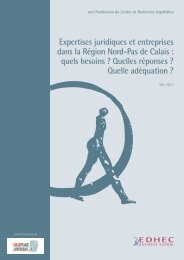Reactions to the EDHEC Study - Faculty and Research
Reactions to the EDHEC Study - Faculty and Research
Reactions to the EDHEC Study - Faculty and Research
Create successful ePaper yourself
Turn your PDF publications into a flip-book with our unique Google optimized e-Paper software.
<strong>Reactions</strong> <strong>to</strong> <strong>the</strong> <strong>EDHEC</strong> <strong>Study</strong> “Optimal Design of Corporate Market Debt Programmes in <strong>the</strong> Presence of Interest-Rate <strong>and</strong> Inflation Risks” - May 20122. Background <strong>and</strong> Methodologysimply a <strong>to</strong>ol <strong>to</strong> pursue active views onfuture inflation or interest rates. If a firmfocuses on liabilities in isolation, issuingdebt which increases variability of debtcosts is naturally contrary <strong>to</strong> <strong>the</strong> goalof minimising <strong>and</strong> stabilising liabilities.The overall goal of a corporate issuer,however, is <strong>to</strong> maximise <strong>to</strong>tal firm value,while evaluating liabilities within its ownconfined framework ignores <strong>the</strong> impac<strong>to</strong>f fac<strong>to</strong>rs affecting <strong>the</strong> entire firm.Particularly for firms with revenue highlysensitive <strong>to</strong> interest rates or inflation (e.g.as depicted in Table 1), evaluating debtwith <strong>the</strong> goal of simple cost reductioncan have substantial effects on <strong>to</strong>tal firmvalue, as <strong>the</strong>se tractable risk fac<strong>to</strong>rs impactcash flows from assets <strong>and</strong> liabilities. Thus,a clear distinction can be made betweena pure liability strategy which segregatesliabilities from firm-wide risk fac<strong>to</strong>rs, <strong>and</strong>one which integrates assets <strong>and</strong> liabilitiesin<strong>to</strong> a single coordinated framework.Parallel <strong>to</strong> a corporate issuer’s integratedasset-liability management strategy isan inves<strong>to</strong>r’s framework which evaluatesasset allocation within <strong>the</strong> context ofits liabilities. With regard <strong>to</strong> both issuers<strong>and</strong> inves<strong>to</strong>rs, employing a strategyconstrained strictly <strong>to</strong> ei<strong>the</strong>r assets orliabilities limits <strong>the</strong> ability <strong>to</strong> hedge firmwiderisks.The adoption of inflation-linked bonds asei<strong>the</strong>r an investment or a form of issueddebt has distinct effects on inves<strong>to</strong>rs <strong>and</strong>issuers, as described in <strong>the</strong> following table.The <strong>EDHEC</strong>-Risk study produces a strong<strong>the</strong>oretical argument that issuanceof inflation-linked bonds could be ofmutual benefit <strong>to</strong> both corporations <strong>and</strong>inves<strong>to</strong>rs. Current practices, however,are in disaccord with this finding, withrelatively few firms issuing inflationlinkedbonds. Thus, it was important <strong>to</strong>isolate <strong>the</strong> perspective of key stakeholderson our conclusions <strong>and</strong> <strong>to</strong> identify anypractical barriers <strong>to</strong> <strong>the</strong> development of<strong>the</strong> corporate bond market.Our analysis of <strong>the</strong> professional perspectivewas meant <strong>to</strong> be comprehensive <strong>and</strong>precise; accordingly, two separatequestionnaires were issued <strong>to</strong> corporatefinance departments <strong>and</strong> institutionalinves<strong>to</strong>rs, with questions tailored <strong>to</strong> <strong>the</strong>irunique concerns.Table 2IssuerInves<strong>to</strong>rPure Liability (or Asset) Focus-Useof fixed-rate debt- Fixed-rate debt allows for reduced risk from a puredebt-management perspective (i.e. it minimisesuncertainty/variability of debt-servicing cost).- If <strong>the</strong> inves<strong>to</strong>r’s focus is on nominal return, st<strong>and</strong>ardfixed debt has a certain cost (ignoring credit risk).Integrated Asset-Liability Focus-Useof inflation-linked debt- Reduces risk from an asset-liability managementperspective; reduces variability of firm-wide cashflows, net of debt payments, thus reducing chance ofdefault <strong>and</strong> as a result, maximising firm value- Allows for inflation risk matching of assets <strong>and</strong>liabilities- Perfect inflation hedge; possibility of directlymatching liabilities tied <strong>to</strong> same inflation index.- If liabilities are linked <strong>to</strong> inflation, <strong>the</strong>n inflationlinkedcorporate bonds are a way <strong>to</strong> create a safeasset – liability-hedging portfolio (LHP).- In particular corporate bonds may be morereasonable than sovereign bonds when hedgingcorporate pension fund liabilities (Scherer 2006).10 An <strong>EDHEC</strong>-Risk Institute Publication





